WESR-Mountains
Introduction
Mountain regions are globally distributed, with specificities based on their altitude and latitude. They are particularly vulnerable to climate change as there is evidence that warming rates are amplified at higher elevations, which not only impacts local biodiversity and populations but has indirect effects far beyond mountainous areas. In this context, mountain research is key to better capture and understand interactions between the various mountain ecosystems with goal to mitigate as much as possible climate change direct and indirect effects in mountain environments.
As data and knowledge sharing play a key role in mountain research, it is essential to have an easy access to existing mountain resources in the most comprehensive way. The goal of this platform is hence to provide access to the most relevant existing resources for the benefit of the various communities concerned with mountain environments.
Explore data
The WESR-Mountains platform, under continuous development, aims to centralize all relevant mountain research content for the benefit of the United Nations. It links as much as possible to existing authoritative sources with proper citation, but also gives access to original data created in the frame of UNEP/GRID-Geneva activities.
|
WESR-Mountains platform A dedicated MapX project for WESR Mountains provides access to key mountain relevant geospatial datasets. These are organized into relevant categories inspired by the work on Essential Climate Mountain Variables led by the Mountain Research Initiative (MRI). Access to these datasets is currently restricted but will be open very soon. Visit the data: https://app.mapx.org/?project=MX-IXP-F6R-H5U-GA8-DTT 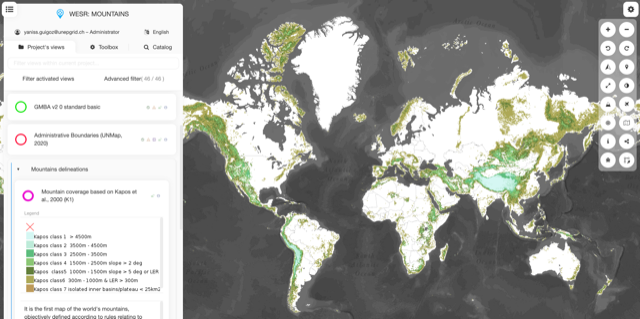
|
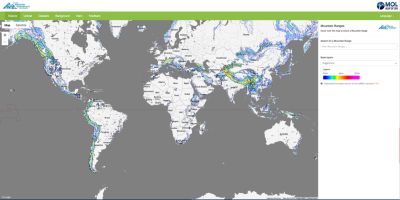 Global Mountain Biodiversity Assessment portal |
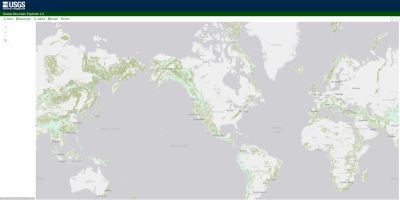 USGS Global Mountain Explorer |
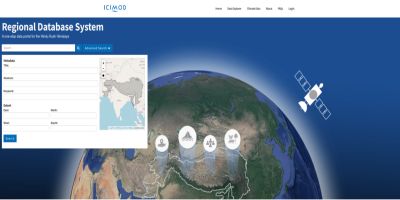 ICIMOD regional database system |
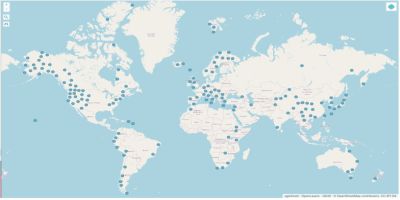 GEO Mountains Inventory of In Situ Observational Infrastructure |
- UNEP mountain related publications : https://www.unep.org/resources?keywords=mountain
- MRI publications: https://www.mountainresearchinitiative.org/activities/mri-publications/mri-publications
- IPCC mountains factsheet : https://www.ipcc.ch/report/ar6/wg1/downloads/factsheets/IPCC_AR6_WGI_Regional_Fact_Sheet_Mountains.pdf
- IPCC chapter on high mountain areas: https://www.ipcc.ch/site/assets/uploads/sites/3/2019/11/06_SROCC_Ch02_FINAL.pdf
- Kapos V, Rhind DJ, Edwards M, et al. (2000) Developing a Map of the World's Mountain Forests. In: Price MF, Butt N (eds.), Forests in Sustainable Mountain Development: A Report for 2000. CAB International, Wallingford. pp 4-9. : https://cabidigitallibrary.org/doi/10.1079/9780851994468.0004#core-collateral-purchase-access
- Körner, C., J. Paulsen, and E. Spehn. 2011. A definition of mountains and their bioclimatic belts for global comparisons of biodiversity data. Alpine Botany 121;73-78 : https://link.springer.com/article/10.1007/s00035-011-0094-4
- Karagulle, D., C. Frye, R. Sayre, S. Breyer, P. Aniello, R. Vaughan, and D. Wright. 2017. Modeling global Hammond landform regions from 250-m elevation data. Transactions in GIS: https://onlinelibrary.wiley.com/doi/full/10.1111/tgis.12265?campaign=wolearlyview
- Africa Mountains Atlas: https://www.unep.org/resources/report/africa-mountains-atlas
- GEO Mountains: https://www.geomountains.org/
- Mountain Research Initiative (MRI): https://mountainresearchinitiative.org/
- Network for European Mountain Research: https://nemor.creaf.cat/
- International Centre for Integrated Mountain Development (ICIMOD): www.icimod.org
- Global Mountain Biodiversity Assessment: https://www.gmba.unibe.ch/
- GLAMOS glacier Monitoring Switzerland: www.swiss-glaciers.glaciology.ethz.ch
- Swiss Federal Institute for Forest, Snow and Landscape Research WSL: https://www.wsl.ch/en/index.html
Contact Us: info@unepgrid.ch
